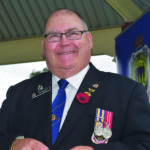William Fleming courtesy of the Jones Family
By Lyn Forde – President/Research Officer of St Marys & District Historical Society Inc.
IN May 1885 a public meeting was held in the Protestant Hall at St Marys to consider the advisability of a petition to the Government in favour of Incorporation. About 200 people were present, most being particularly interested in tanning. While a number had announced they were in favour to Incorporation did not turn up. Mr J Shand J.P was voted “Chair” and said that the subject should be fully considered as to whether the meeting was favourable to a Municipality or not, because sooner or later they would be compelled to accept local Government. Mr John King Lethbridge J.P. moved that in the opinion of the meeting, the town and district of St Marys should be established as a Municipality and he was sorry to hear there would be great opposition and he was of the opinion that people were not really studying their own interests and he, for one, would not have made a move in the matter did he not think it would be of great benefit. He was aware that some people believed he had no stake in their district because he had a few allotments in the town and was Agent for a large lot of property, but he represented Mr King and like himself they were quite willing to be taxed knowing how the value of property would be increased. He asked that freeholders especially should consider the matter and there may be some present who were not interested but would vote. He believed that the meeting should have been called for freeholders and householders and those present would quite agree with him that their highways were in a defective state. Should you go to the adjoining township of Penrith for proof of the value of Incorporation, there the streets and roads were all in good repair. Many would remember what a bad state the streets and roads of that locality were in before Incorporation. There was great opposition to Incorporation there so much so that the place was very nearly not a Municipality. John understood one of the Penrith Aldermen was to have been present that evening and he considered him the best to explain various matters in connection with municipal work, but consequently he had thought very little of the matter. Let anyone go to Camden and see the state of the roads and footpaths where it was dangerous for people to walk after dark and the same could be said of Putland street at St Marys where it was in a disgraceful state. The tanners were greatly opposed to Incorporation, but he could say to them that the Towns Police Act could deal with them just as well as a Municipality if they became a nuisance. In Windsor, Richmond and even in the town of Penrith there were tanneries right in the heart of the towns. To show that these people could be dealt with as well by the Towns Police Act he referred to a case in their own town when Mr Webb’s tannery had become a nuisance to the Public School, and he was brought before the Police Court and after £100 had been spent in improving the place there was not a sign of smell arising from it that was not the case with others. There was also a slaughterhouse right in the heart of the town and although not more than 60 feet from the road was perfectly clean and sweet and John had heard many visitors ask how it was St Marys was not Incorporated? but he could not tell them. He knew if the Government granted £500 for Church Street they would gladly accept it, although some would not help themselves by Incorporation where the Government gave pound for pound on all that was raised. Another thing, the Government proposed shortly to bring in a Local Government Bill that would compel everyone to become taxpayers and he urged those present to have St Marys Incorporated making it a place worthy of the name and worthy of its residents. It would never be a large town until it was Incorporated”. Mr James Richard Woodlands seconded the motion and explained he did not intend inflicting upon them a long speech by telling them something of which he knew nothing, but he believed in Municipalities as it meant progression and he certainly hoped the young men of St Marys would jump up and not be in the same old conservative mood. There would be no fear of interfering with existing industries. Mr John Harris said he will oppose it at all events. Mr William Fleming said he will support it as he believed in getting rid of the old 50 years style. Mr Garner also supported the resolution and said that none could deny the roads were in a bad state with some in fact being in a state of nature where vehicles had to wind round and round as much as if they were in the bush. At the request of the promoters Mr A Colless proceeded to explain the working of Municipalities when he was objected to as having no interest in the district, but after some further discussion it was agreed that he should be allowed to explain the general working of Municipalities. A motion was put by the Chairman with the result after carefully counting declaring the motion carried which caused a scene of confusion by a slight mistake, especially as only the freeholders and householders could vote and this time the motion was lost. The Municipality was proclaimed in 1890, the first Council met in the Protestant Hall with William Garner elected as the first Mayor. At a meeting in January 1891, William Fleming was elected one of the Alderman on the Council and said that “he thought people who kept themselves in one corner of the globe for any length of time, would naturally grow conservative and preferred the old way as best. They desired no change and wanted no improvement because what suited their grandparents suited them, so they opposed all local advancements, showing very clearly that their minds were as narrow as the extent of their travels”. But the Nepean Times noticed that they thought those who opposed Mr Fleming and others in establishing a Municipality for St Marys could already see the advantages of it as it was growing into shape and will yet become one of the prettiest and cleanest townships in the colony. The Council unfortunately did not get a home of their own until their building on Mamre Road was opened in 1932, now the Headquarters of the Historical Society. St Marys ceased to be a Municipality in 1948 when it was amalgamated into the City of Penrith.
Source: Nepean Times, Trove.






